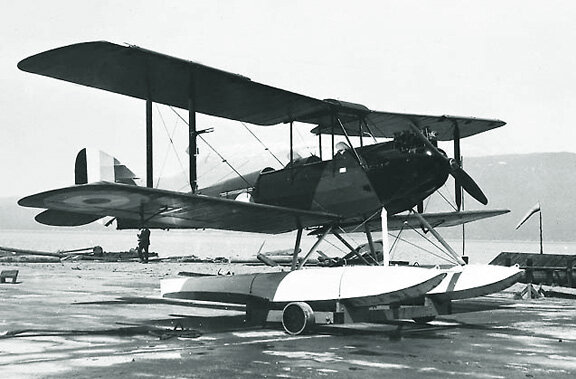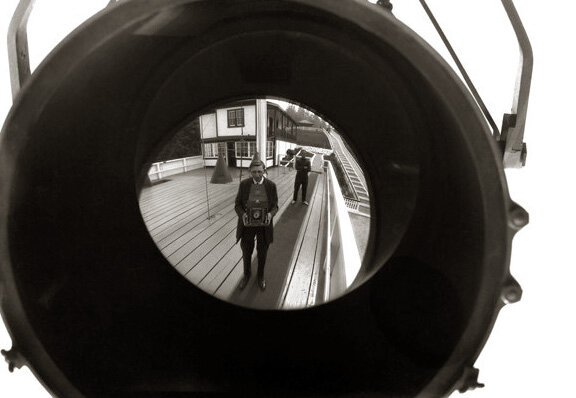SAVED FROM THE BRINK
A lone float-equipped de Havilland DH 60M Cirrus Moth of 11 (AC) Squadron of the newly formed Royal Canadian Air Force floats past photographer Cyril R. Littlebury while standing on the deck of the marine signal station that was located at Prospect Point in Stanley Park. The photo was taken sometime after 1934, it was well before completion of the Lions Gate Bridge ( November 1938 ), which would be in the photo were it taken today. Littlebury was a great recorder of waterfront life in Vancouver during the early years of the 20th century and Prospect Point was a favourite spot to capture photographic images of one of his preferred subjects - ships. More than likely the arrival of the low flying Moth was a serendipitous event Littlebury was happy to capture, while panning the camera at the perfect speed. Photo by Cyril R. Littlebury via www.historicphotos.ca
Unlike a painting which is the artist's perception of what he sees, a photograph captures that moment in time when the shutter is released. Photography, especially that of its early practitioners, allows the viewer a chance to see the world at that time, looking through the lens, just as the photographer did. A photograph captures a fraction of a second of time and it is through this that we understand its passing. But time is merely captured. It is not stopped. Eventually the ephemeral moment will disappear into a basement or an attic - a waypoint on its way to the landfill, to rot and return into its constituent chemicals. Even the finest images by the finest practitioners of the photographic art form will eventually fade from view, despite the best efforts of conservators. Without the photographer to watch over them, many photographic negatives and prints are subject to even quicker misfortune. Unless of course, they are rediscovered by someone who understands what they are.
In the early 1940s, Alfred Booth was hired to remove litter from a vacant house in Vancouver, British Columbia. Amongst the newspapers, broken furniture and detritus of other people's lives he found a wooden box containing approximately 1,000 photographic negatives. Unwilling to trash this box of time as instructed to do, Alfred took the box home and gave them to his fourteen year old son Dudley in 1946. Over the ensuing decades, this remarkable collection of historic images from the early 20th century endured because Dudley Booth understood that they were a valuable record. They were the life's work of a man called Cyril R. Littlebury. Born in England in 1898, Cyril moved with his family - first to New Zealand and then eventually to settle in Calgary, Alberta.
Cyril worked at a number of jobs, but was first and foremost an avid photographer. Working as a fireman for Canadian National Railways, he started to photograph railway scenes and equipment. He eventually moved to Vancouver and continued his work as a photographer - recording life in the city and the surrounding region. Until Dudley brought the negative collection to light in the 1990s, there were no negatives of his work known to exist. In fact Booth only discovered the artist's name in recent years. And because there existed a sizeable collection of his railway prints in Toronto, it was thought that Littlebury was simply a railway photographer.
He was far from that, as Dudley Booth would prove. Littlebury's oeuvre was a remarkably elegant and precisely crafted collection of images depicting urban and scenic life in Western Canada in the early decades of the 20th century. Among the astonishing collection of images of life in and around Calgary and Vancouver, Booth discovered several photographs of aircraft. It is these four images of early aviation in Western Canada that struck a powerful note with Vintage News and connected us with Littlebury and Booth. If it were not for Booth and his father, these four sharply focused images would now be compacted dust in the depths of a land fill, and these four moments in time that passed before Littlebury's lens so long ago would have been lost.
By the time Booth discovered the name of the images' creator, technology existed for scanning the images and digitally restoring some of the damage or cleaning up imperfections. Now, with the scans stored in three separate locations, there is a good chance that these moments will now live forever. The images, though beautiful, are more powerful now simply because they were very nearly lost. Life is, as we know, more wonderful after a near death experience. So too is art. That smiling light from the de Havilland Moth pilot's smile will beam from his cockpit down the corridor of time because of good fortune. The ground crew at High River will now struggle to heave the tail of that DH-4 onto the trolley of eternity. For these four images saved from the midden of time, we thank first Littlebury and foremost Booth.
They will forever add to our ability to see back into time.
Littlebury’s Photos Saved From the Brink
Littlebury's opening photograph (top) of the 11 Squadron Cirrus Moth at Prospect Point reveals remarkable detail on close inspection. One can see and read the Moth logo on the nose, small aircraft shaped silhouettes painted on the struts and the smile on the face of the pilot as he gazes back at Littlebury. No. 11 Squadron was an Army Co-operation (AC) unit and commenced training when it received 4 Cirrus-powered de Havilland Moth aircraft in October of 1934, allowing us to date this somewhere between late 1934 and 1935, for Littlebury died of Cancer in 1936, and it is unlikely that he was well enough to take photos during the last year of his life. Photo by Cyril R. Littlebury
Prospect Point from water level on May 16th, 1923. It was while standing atop this point at the Marine Signal Station more than ten years later that Littlebury captured the image of the 11 Squadron Moth. Photo by Cyril R. Littlebury
This photo of one of the four 11 Squadron Cirrus Moths at Sea Island was not taken by Littlebury, but gives us a different angle on the airplane. Photo: DND
Related Stories
Click on image
From Prospect Point, Littlebury had an almost aerial view of passing steamers and ferries. Here a CPR coastal steamer, the Princess Alice lays on the coal as she steams past. Photo by Cyril R. Littlebury
A brand spanking new Coastal Airways Bellanca CH-300 Pacemaker taxies slowly under the power of her 300 HP Wright Whirlwind engine circa 1931. This aircraft was built in 1930 and would be destroyed by fire in Nakina, Ontario while Austin Airways mechanics were heating her engine in February of 1944. Photo by Cyril R. Littlebury
A Curtiss H2SL - lovingly referred to by its crews as the Flying Forest for its forest of wooden struts - was one of the most beautiful aircraft to ever fly off water. This particular airplane (G-CYEB) was a former US Navy flying boat (A1985) and served at No.1 (Operations) Squadron at Jericho Beach Flying Boat Station, British Columbia. Littlebury's records indicate that this image was shot circa 1928, but the aircraft's records indicate that it was struck off service in 1925. There were five HS-2L flying boats based at Jericho - all ex-USN. The station was constructed in 1920 by the Federal Air Board and became the first Canadian Air Base. In 1924 it became the first R.C.A.F. base in British Columbia representing an important milestone in Air Force history. During the 1920s and early 30s flight services from this station were used by federal and provincial ministries for patrolling, inspecting and transportation along the rugged coastal waterways to remote communities. Photo by Cyril R. Littlebury
Before moving to Vancouver, Littlebury lived and worked in Calgary, Alberta. Just a few miles south of Calgary was the Canadian Air Force airfield at High River. No.2 Operations Squadron DH-4 aircraft were based there and used for forest fire patrols and a considerable amount of aerial photographic survey of Alberta and Saskatchewan. Here we see a de Havilland DH4 (G-CYCW - Ex RAF F2713). These large biplanes were converted in Canada to a single seat configuration. Photo by Cyril R. Littlebury
Zooming in closer we see that ground crew are lifting the tail of the big bi-plane onto a wheeled cart, enabling them to move it about without the drag of the skid in the grass. The pilot is checking the controls in the cockpit. Photo by Cyril R. Littlebury
Though we normally publish only aviation-related stories, we would be remiss if we didn't show you exactly why Littlebury's once-lost collection of nearly a thousand photographs is so important to our understanding of life in the west in the early 20th century. Here we see Littlebury, his wife Ashley, and his mother and father, Helena, and Arthur, standing before the White Café on the Main Street of Cochrane, Alberta. They are driving what was described as a ‘centre’ door, Ford Model T. The photo is revealing in that even though this is Western Canada in the 1920s, there are no longer horses on the dirt main street of this farming town. Most of the buildings in this photo are still standing, in what is now called, the Old Town of Cochrane. Photo by Cyril R. Littlebury
Littlebury's photo caption identifies this as the Gillespie farm. Here again we see Littlebury with wife and parents in the photo. Photo by Cyril R. Littlebury
Littlebury was obviously fascinated by transport - trains, ships and aircraft. In this shot, the Canadian Pacific Steamships Ltd. liner Empress of Asia is about to leave from a pier in Vancouver. Passengers have thrown streamers down to their families who have come to see them off. Other than two assignments as a troopship in the First and Second World Wars, the Empress of Asia spent her whole career transporting cargo and passengers between the Orient and British Columbia. On February 5th, 1942 while in convoy approaching Singapore the Empress of Asia was lost by enemy action. Photo by Cyril R. Littlebury
The coastal steamer S.S. Cardena of Union Steamships - as captured by Littlebury from Stanley Park. Photo by Cyril R. Littlebury
A rare and creative self-portrait of Littlebury - reflected in the mirror of the searchlight that was located at the end of the deck of the Marine Signal Station at Prospect Point, Stanley Park. Elsewhere on the www.historicphotos.ca site, are photos of the signal station, searchlight and its location. The signal station operator hoisted large symbols up a flag pole to tell the ships, the direction of the tidal flow and if another vessel was also entering the narrow channel in the opposite direction. One look at the size of Littlebury's camera and you have a better appreciation of his work and the difficulty he would have panning the opening image of the Cirrus Moth. Not only are we looking at a precise point in time, but right into the eyes of the photographer himself. Photo by Cyril R. Littlebury



















